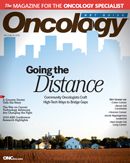Publication
Article
Oncology Live®
ASH 2010: Data Support Escalated BEACOPP as Superior Method of Tumor Control in Early Unfavorable Hodgkin Lymphoma
Author(s):
In patients with early unfavorable Hodgkin lymphoma, an escalated BEACOPP regimen was superior to standard treatment at improving tumor control, according to final data from the German Hodgkin Study Group HD14 trial.
In patients with early unfavorable Hodgkin lymphoma, an escalated BEACOPP regimen was superior to standard treatment at improving tumor control, according to final data from the German Hodgkin Study Group HD14 trial. “We achieved overall better tumor control with more aggressive treatment. The toxicity was a little higher hematologically, but this did not result in more treatment-related deaths,” said Andreas Engert, MD, University Hospital of Cologne, Germany, who spoke about the study at a press briefing. “This is now our stan- dard of care.” The escalated BEACOPP regimen failed to demonstrate improved overall survival (OS), but Engert said this might change with longer follow-up.
Combined modality treatment consisting of 4 cycles of BEACOPP chemotherapy and involved-field (IF) radiotherapy is currently standard therapy for patients with early unfavorable Hodgkin lymphoma. BEACOPP comprises bleomycin, etoposide, Adriamycin (doxorubicin), cyclophosphamide, vincristine, procarbazine, and prednisone. In the earlier HD8 study, conducted by the same investigators, the standard BEACOPP regimen was associated with a 5-year OS rate of 91% and freedom-from-treatment-failure rate of 83% .
“The rationale for HD14 was to improve on these results by increasing the dose intensity using BEACOPP escalated,” Engert explained. The escalated regimen included 10 mg/m2 of bleomycin, 200 mg/m2 of etoposide, 35 mg/m2 of Adriamycin, and 1250 mg/m2 of cyclophosphamide plus standard doses of vincristine, procarba- zine, and prednisone.
The study enrolled 1655 patients aged 16 to 60 years with early disease. Patients with stage I-IIA Hodgkin lymphoma were required to have at least one of the following risk fac- tors: large mediastinal mass, extranodal dis- ease, elevated sedimentation rate, or ≥3 nod- al areas. Patients with stage IIB disease were required to have an elevated sedimentation rate or ≥3 nodal areas. Two-thirds of the pa- tients had stage IIA Hodgkin lymphoma.
Patients in the treatment arm received 2 cycles of the intensive BEACOPP regimen followed by 2 cycles of standard ABVD (Adria- mycin, bleomycin, vinblastine, and dacarba- zine), followed by IF radiotherapy at 30 Gy. Patients in the control arm received 4 cycles of ABVD followed by the same dosage of ra- diotherapy. The primary objective was to reduce treatment failures.
In the final intent-to-treat analysis (N = 1528), 87.6% of patients receiving standard treatment were free from treatment failure (relapses and deaths) at 5 years compared with 94.3% of patients receiving es- calated BEACOPP (P <.0001). “This absolute improvement of about 7% met our predefined criteria for stopping the trial and resulted in a new standard of care for us,” said Engert.
The response rate was 95% with either regimen, but the escalated BEACOPP regimen was associated with significant improvement in the rates of progressive disease, early relapse, and late relapse (Figure). For example, only 0.8% of patients treated with escalated BEACOPP expe- rienced progression compared with 3.0% of patients on standard ther- apy. “These were stunning differences in tumor control,” said Engel.
In each arm, 20 patients died; 5 treatment-related deaths occurred in the BEACOPP arm and 4 in the ABVD arm. Secondary neoplasias developed in 19 patients on standard therapy and 16 patients receiving escalated BEACOPP. Patients in the escalated BEACOPP arm also experienced a higher rate of grade 3/4 hematologic toxicity compared with patients in the ABVD arm (70% vs 30%, respectively).
Engert noted that the trial involved patients at 350 centers in 4 European countries. “This represents a very broad experience, with even small oncology centers taking part,” he said.
Ginna G. Laport, MD, associate professor of medicine in the Division of Blood and Marrow Transplantation, Stanford University Medical Center, California, who moderated the press briefing, said she currently reserves the standard BEACOPP regimen for patients with more advanced disease. “I can’t say I would change practice based on this, though the results are titillating,” she observed. “This is a very large and well-conducted trial... though the toxicity is concerning, there was no difference in treatment-related mortality.” She said it might not be unwarranted for some physicians to switch to the escalated BEACOPP regimen.










